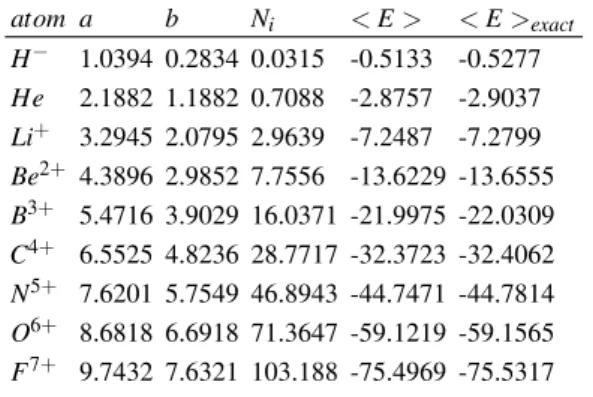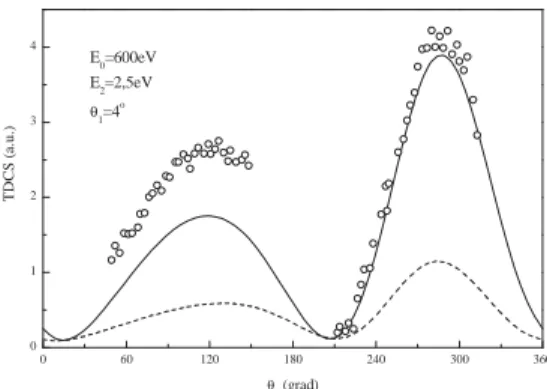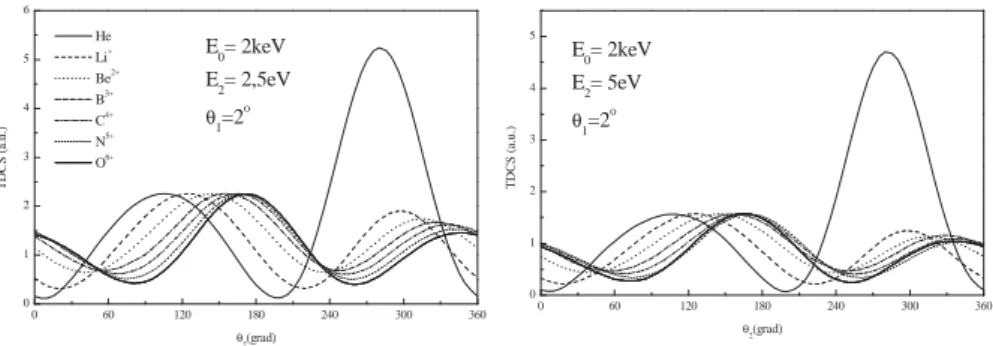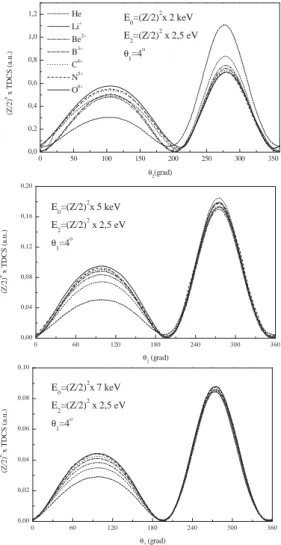Electron Impact Single Ionization of the He-Isoelectronic Sequence
A. L. Frapiccini1,2, K. V. Rodriguez1, G. Gasaneo1, and S. Otranto1 1Departamento de F´ısica, Universidad Nacional del Sur and CONICET,
8000 Bah´ıa Blanca, Buenos Aires, Argentina. 2Centro At´omico Bariloche and CONICET,
8400 Bariloche, R´ıo Negro, Argentina.
Received on 12 April, 2007
In this work, triply differential cross sections for single electron emission due to electron impact on the He-isoelectronic sequence are calculated by using a Born-C3 model. The influence of the nuclear charge on the angular distributions is analyzed. The validity of a scaling law initially derived in the framework of photo-double-ionization is discussed.
Keywords: Electron collisions; Single ionization; Fully differential cross sections; He-isoelectronic sequence
I. INTRODUCTION
The electron-impact single ionization of He has been sub-ject of many studies during the last thirty five years. The tech-niques to measure Triply Differential Cross Sections (TDCS) were developed in the late 1960s [1, 2]. Since then, the im-provement of these techniques systematically pushed theoreti-cians to improve the usual models employed in order to de-scribe that problem.
From the theoretical point of view, the high energy models based on Born and eikonal-Born series were the standard in order to describe the collision process (see [3] for a review). By the end of the 1980s, Brauneret al. showed that the inter-electronic interaction must be included in the final state wave function in order to correctly describe the angular distribu-tion of the emitted electron for single ionizadistribu-tion of hydrogen [4]. In that work the separable C3 model consisting in the product of three Coulomb wave functions, previously used in ion-atom collisions [5], was employed to represent the two electron continuum together with an uncorrelated Born initial state which mainly consists in a plane wave for the incoming projectile times a bound state for the target atom. This ap-proximation clearly improved the description of angular dis-tributions for electrons impinging with intermediate and high energies. This model was soon afterwards adapted to describe the single ionization of He [6], by representing the two elec-tron continuum by means of the C3 model and considering an effective residual charge for the remaining ionic core. In this work, the C3 model correctly reproduces the experimen-tal data for asymmetric geometries.
On the other hand, in the threshold region where the Wan-nier emission mechanism prevails [7], the C3 model fails by orders of magnitude to the absolute cross sections due to an overestimation of the interelectronic repulsion. This model, being a solution of an approximated Hamiltonian which ne-glects thekinetic-correlation given by the non-diagonal terms of the metric tensor, does not include any information on the screening of the electron-electron interaction by the ionic core. This leads to an exponential decreasing behavior for the cross sections, instead of the well known power law depen-dence arising from Wannier theories.
The evaluation of the different models in the Wannier re-gion could be also performed through the study of the consid-ered atom isoelectronic-sequence, since the threshold region is then extended to higher energies [8]. These studies could in-clude the analysis of the possible scaling of the different cross sections. In 1994 Kornberg and Miraglia derived scaling laws for n-differential cross sections for photo-double-ionization (PDI) of the He-isoelectronic sequence which have been the-oretically tested during the last ten years [9–11]. A few years ago, Stiaet al. confirmed that the same scaling laws are also valid for single-ionization of the hydrogen-isoelectronic se-quence by electron impact [12]. However, up to our knowl-edge, no-similar analysis has been performed for the He-like ions for different target nuclear masses.
During the last years, many other authors concentrated to-wards the improvement of the C3 wave function for the three-body continuum in the low energy limit. In some cases, C3 -like models based upon the introduction of momentum and coordinate-dependent Sommerfeld parameters in the standard C3 model proved to be useful in (e,2e) and (e,3e) processes together with Born initial states [13–17]. These analysis were based on the satisfaction of several spatial and energetic as-ymptotic limits, giving different behaviors for the wave func-tions in the usually denominated reaction region, where all the particles are close to each other. In many physical processes, the initial bound state modulates the contribution of the con-tinuum wave functions to the transition amplitude, and a correct description of the reaction region turns vital. Only continuum-continuum transitions include information from the asymptotic regions where these models are supposed to be valid.
Analytical models based on several variables hypergeomet-ric functions were also developed by asking the wave function the satisfaction of several desirable physical limits [18, 19]. However, these models which partially introduce thekinetic -correlation have been only applied to photo-double ionization of He [20] and up to date they have not been tested in single ionization of atoms by light particle impact.
TABLE I: Variational parameters for the He-isoelectronic sequence according to Eq.(9)
atom a b Ni <E> <E>exact
H− 1.0394 0.2834 0.0315 -0.5133 -0.5277
He 2.1882 1.1882 0.7088 -2.8757 -2.9037
Li+ 3.2945 2.0795 2.9639 -7.2487 -7.2799 Be2+ 4.3896 2.9852 7.7556 -13.6229 -13.6555 B3+ 5.4716 3.9029 16.0371 -21.9975 -22.0309 C4+ 6.5525 4.8236 28.7717 -32.3723 -32.4062
N5+ 7.6201 5.7549 46.8943 -44.7471 -44.7814 O6+ 8.6818 6.6918 71.3647 -59.1219 -59.1565 F7+ 9.7432 7.6321 103.188 -75.4969 -75.5317
continuum by expanding the total wave function in an orthog-onal Laguerre basis treating the target continuum via a square-integrable representation. This method though not satisfying the correct asymptotic limits has been applied with success for the He target case.
In this work we evaluate the single ionization of the He-isoelectronic sequence by electron impact. In section 1, the theoretical background is presented. In section 2, the angu-lar distributions for the ionization of He-likeions are obtained and different effective charges for the remaining ionic core are proposed and evaluated. Results for different impact energies and scattering angles are presented and discussed. The valid-ity of the scaling law initially derived by Kornberg and Mi-raglia in the PDI context is evaluated and discussed. Conclu-sions and outlooks are presented in section IV. Atomic units are used unless explicitly stated.
II. THEORY
The triply differential cross section for the electron impact ionization of Helium is given by
d3σ
dΩ1dΩ2dE1
= (2π)4k1k2
k0 µ
1 4|T
S f i|2+
3 4|T
T f i|2
¶ (1)
where the direct and exchange transition matrix are given by
Tf iS= (1+
P
12)Tf i(k1,k2) (2) Tf iT = (1−P
12)Tf i(k1,k2)Here, k1,2 represent the momenta of the outgoing projectile and the emitted electron respectively,k0the incoming projec-tile momentum and
P
12the permutation operator.The transition amplitudeTf iin the two active electron rep-resentation in prior form is given by
Tf i=hΨ−f |Wi|χ+i i, (3) whereΨ−f represents the product of a wave function for the double continua for the scattered and ejected electrons times
a wave function for the remaining bound electron. χ+i is the initial state andWiis the perturbation given by the part of the Hamiltonian that is not solved byχ+i . In the present analysis we use an uncorrelated Born initial state which consists on a plane wave for the incoming projectile times a bound state representing the 1s2(1S)state for the ground state of the atom.
χ+i = (2π)−3/2eik0·r1Ψ
1s2(r2,r3). (4) The perturbation is then given by,
Wi=−ZrT
1
+ 1
r12
+ 1
r13
(5)
It could be observed that the perturbation operator consists in the projectile-nucleus interaction, and the interaction of the incident projectile with the two active electrons in the bound state.
It should be noted that this is a high energy approximation and a more precise representation would include Coulomb or eikonal waves to represent the interaction between the imping-ing projectile and the target. For that reason, in the followimping-ing we restrict ourselves to study high energy collisions involving low momentum transfers by the projectile. It has been already shown in Ref. [12] that even a much simpler model than the one here employed, like the First Born Approximation, pro-vides in this regime almost identical results compared to more elaborated CDW models.
For the continuum state part of the final wave function we use the C3 model,
Ψ−C3=Ψ1s(r3)
√
2(2π)−3NC−3eik1·r1+ik2·r2 (6)
×
∏
j=1,2,12
1F1[iaj,1,−ikjrj−ikj·rj],
being aj=Zjµj/kj with j=1,2,12 the Sommerfeld para-meters, Zj the charges, µj the relative masses and k12 =
(k1−k2)/2. The
√
2 is included to compensate since the wave function is not symmetrized. The wave functionΨ1s(r3) rep-resents the remaining bound electron in the ion. The normal-ization factor obtained from the Redmond asymptotic condi-tion in theΩ0region where the three particles are far from each other is given by,
NC−3=
∏
j=1,2,12
e−π2ajΓ(1−ia
j). (7)
For two electrons in the field of an ionic core, the Sommerfeld parameters are given by
a1=− Ze1
k1
(8)
a2=− Ze2
k2 a12=
1 2k12
FIG. 1: Ratio of the variational to the exact binding energy as a func-tion of the nuclear chargeZfor the wave function.
For the initial state, we use a simple Bonham and Kohl type wave function [22] which only includes radial correlation:
Ψ1s2(r2,r3) =Ni(e−ar1−br2+e−br1−ar2) (9) whereaandbare the variational parameters which are deter-mined for differentZcharges as presented in Table I.
This wave function is supposed to be more precise as the nuclear charge increases. In Fig. 1 we present the ratio be-tween the variational and the exact binding energies. As could be seen, for the lower charges the angular correlation seems to give a significant contribution but as the nuclear charge in-creases, the binding energy is almost recovered by just includ-ing radial correlation. This means that as the nuclear charge increases so does the nuclear field, turning the electrons in-sensitive to their relative positions. Then, the inclusion of the screening or radial correlation suffices to give a good descrip-tion of the two-electron system.
III. RESULTS
According to the models introduced in the previous section, we can stress that the most important weakness of the present theory relays in the treatment of the ionic chargesZe1,e2which must be empirically included.
A more elaborate description would include the solution of an effective radial potential, as could be a Herman-Skillman potential based on the Hartree-Fock methodology. However, based on the good qualitative results obtained in the follow-ing analysis we represent screenfollow-ing effects through effective charges.
Since we restrict the present analysis to very asymmetric geometries, we now consider and evaluate two different mod-els for the ionic charges: a) Ze1=Ze2= (ZT−1) and b) Ze1= (ZT−1), Ze2= (ZT−5/16).
These models mainly differ in how the remaining bound electron after the collision screens the nuclear charge. In the first model, which could be considered a high energy limit, the
0 60 120 180 240 300 360
0 1 2 3 4
E
0=600eV
E2=2,5eV
θ1=4o
T
D
C
S
(
a.
u
.)
θ2 (grad)
FIG. 2: TDCS under asymmetric geometry. The impinging energy is 600eV and the scattering angle considered is 4◦. The emission energy is 2.5eV. Theories: solid-line: Ze1,e2=ZT−1, dashed-line:
Ze1=ZT−1 andZe2=ZT−5/16.
scattered projectile and the emitted electron see the nuclear charge reduced in one unit. In other words, they see the max-imum possible screening of the nuclear charge by the remain-ing bound electron. This model was already used by Brauner et al. [6] for electron impact ionization of He in the high en-ergy limit under asymmetric configurations. As a result they obtained good qualitative agreement with experimental data. In the second model, the scattered projectile sees an effective chargeZT−1, while the slowly emitted electron now sees a partial screening ZT−5/16. As it was pointed out by Be-rakdar and Briggs [23], within the frame of an equal energy sharing analysis, it could be expected that the ionic charge seen by a fast receding particle should tend toZT−1 as its energy tends to infinity. According to this, they proposed a functional form for the core charge by fitting available exper-imental data. However different ways to approach the high energy limit could be considered. In this sense, the second model recovers part of this philosophy but makes no use of experimental data to fix the charges.
In Fig. 2, we present the TDCS under asymmetric energy conditions for electron impact ionization of He. The imping-ing energy is 600eV, the scatterimping-ing angle considered is 4◦and the emission energy considered is 2.5eV. The absolute exper-imental data of Junget al. [24] are included for comparison to the theoretical results. The two above proposed models are compared and as a result, we conclude that modela is the one which better approximates the shape of the data. This could be explained by comparing the different partial waves obtained as a solution of the radial two particle Coulomb prob-lem, including the presence of a second electron by a Herman & Skillman type potential. For emission energies lower than 5eV, we found that only thel=0 partial wave is modified by the screening, the other partial waves being coincident with the Coulomb partial waves forZ=1. Then in the forthcom-ing analysis we restrict ourselves to modela.
0 60 120 180 240 300 360 0
1 2 3 4 5 6
0 60 120 180 240 300 360
0 1 2 3 4 5
T
D
C
S
(
a.
u
.)
θ2(grad)
He
Li+
Be2+
B3+
C4+
N5+
O6+
E0= 2keV E2= 2,5eV
θ1=2 o
E0= 2keV
E2= 5eV
θ1=2o
T
D
C
S
(
a.
u
.)
θ2(grad)
FIG. 3: TDCS in asymmetric geometry for an impact energy of 2keV for scattering angle 2◦. Two different emission energies are considered: 2.5eV and 5eV. Theories: solid-line:He; dashed-line:Li+; dotted-line:Be2+; dot-dashed-line:B3+; dash-dot-dotted-line:C4+; short-dashed-line:N5+.
0 60 120 180 240 300 360 0,0
0,2 0,4 0,6 0,8 1,0 1,2
0 60 120 180 240 300 360 0,0
0,2 0,4 0,6 0,8 1,0 1,2 1,4
T
D
C
S
(a
.u
.)
θ2(grad)
He Li+
Be2+
B3+
C4+
N5+
O6+
E0= 2keV
E2= 2,5eV
θ1=4o
E0= 2keV E2= 5eV
θ
1=4 o
T
D
C
S
(
a.
u
.)
θ2(grad)
FIG. 4: Same as Fig. 3 for a scattering angle of 4◦. Theories: solid-line: He; dashed-line: Li+; dotted-line: Be2+; dot-dashed-line: B3+; dash-dot-dotted-line:C4+; short-dashed-line:N5+; short-dotted-line:O6+.
is 2◦. All the curves have been scaled to the He case and we have normalized the results to the recoil peak maximum value. In both situations, we can see that the double collision mecha-nism becomes dominant as the nuclear charge increases. This means that ionization through a single collision mechanism between the projectile and the emitted electron is much less probable than a two step mechanism, where the electron is first hit by the projectile and then is scattered by the nucleus. It could also be observed a significant shift in the positions of both peaks. This could be attributed to the fact that for high Z-values, the bound electrons are closer to the nucleus and so the ionization is more similar to the large impact parameter. It is less probable for the projectile to produce a“head-on” colli-sion because the atom is smaller. Then, the large impact para-meter situation is enhanced just because a simple reduction of the atomic size occurs. It is also well known that high impact parameter collisions occur mostly through the momentum ex-change between the emitted electron and the nucleus, explain-ing why the recoil peak turns to be the dominant structure in the spectrum. In Fig. 4 a scattering angle of 4◦is considered. The impact energy and emitted electron energies are the same as in Fig. 3. Similar trends can be observed, which give clear footprints of the enhancement of the contribution to the cross
sections arising from double-collisions.
In 1994, Kornberg and Miraglia [9] derived a scaling law for the nuclear charge dependence of the PDI cross sections.
σtot(Ef,ZT)→ 1 ZT4σtot
¡
Ef/ZT2,ZT=1 ¢
(10)
dσ
dE1→ 1 Z6T
dσ
d¡ E1/ZT2
¢ ¡
Ef/ZT2,ZT =1¢ (11) d5σ
dΩ1dΩ2dE1→ 1 Z6T
d5σ
dΩ1dΩ2d ¡
E1/ZT2 ¢
¡
Ef/ZT2,ZT =1 ¢
(12)
0 50 100 150 200 250 300 350 0,0
0,2 0,4 0,6 0,8 1,0 1,2
0 60 120 180 240 300 360
0,00 0,04 0,08 0,12 0,16 0,20
0 60 120 180 240 300 360
0,00 0,02 0,04 0,06 0,08 0,10
He Li+
Be2+
B3+
C4+ N5+
O6+
E0=(Z/2)2x 2 keV
E2=(Z/2)2 x 2,5 eV
θ1=4o
(Z
/2
)
6 x
T
D
C
S
(
a.
u
.)
θ2(grad)
E 0=(Z/2)
2 x 5 keV
E 2=(Z/2)
2 x 2,5 eV
θ
1=4 o
(Z
/2
)
6 x
T
D
C
S
(
a.
u
.)
θ2 (grad)
E 0=(Z/2)
2 x 7 keV
E 2=(Z/2)
2 x 2,5 eV
θ1=4o
(Z
/2
)
6 x
T
D
C
S
(
a.
u
.)
θ2 (grad)
FIG. 5: Scaled TDCS corresponding to impact energies 2keV, 5keV and 7keV for He and scattering angle 4◦. Theories: dash-dot-dotted-line: He; short-dotted-line: Li+; short-dashed-line: Be2+; dot-dashed-line: B3+; dotted-line: C4+, dashed-line: N5+, solid-line: O6+.
is more prominent when compared with the He target case. This feature could be explained as follows. It is well known from single ionization of He under asymmetric geometries, that the recoil peak intensity decreases as the projectile energy increases or as the projectile wavelength decreases compared to the target size.
For high charges, the two-electron system is quasi-separable and the energy is proportional to the second power of the charge. The scaled Schr¨odinger equation leads to a scaled momenta (wavelength) which behaves asZT (1/ZT). Thus, according with the independent particle model the size of the atom and the wavelength of the electrons in the con-tinuum scale with the same law. As consequence, the angular
distributions should not be altered when the nuclear charge is modified. However, in the real two-electron system an in-creasingly significant departure from the independent particle model is observed when the nuclear charge is lowered towards the He limit. In that situation, the electron-electron correlation keeps the atomic size bigger than the one resulting from the independent particle model. The mentioned difference then recreates a high energy situation where the recoil peak reduces its size compared to the binary one. By the other side, as the nuclear charge increases, the atomic size to projectile wave-length ratio decreases and tends to a constant, fact which leads to the convergence of the scaling.
IV. CONCLUSIONS AND OUTLOOKS
In this work, we have presented TDCS for the ionization of two electron ions by electron impact. We have used a Born-C3 model which entirely considers in the final state the Coulomb interactions between the scattered projectile, the emitted elec-tron and the remaining ionic core.
The influence of the nuclear charge on the angular dis-tributions obtained at fixed energetic and angular configura-tions has been analyzed and explained considering the rela-tion between physical emission mechanisms and the respec-tive atomic size. From our calculations, a more intense re-coil peak has been obtained in all cases as the nuclear charge considered was increased. This has been attributed to the fact that the simple reduction of the atomic size enhances the relevance of large impact parameter collisions which mainly occur through the momentum exchange between the emitted electron and the nucleus.
We have shown that the Kornberg and Miraglia scaling laws, already proved in(γ,2e)and(e,2e)processes consist-ing in pure three body final states, are also valid in the context of dressed remaining cores. This would imply that these scal-ing laws are related to the number of electrons which are in the continuum, but not to the internal structure of the consid-ered atom. Further investigations are being addressed in that direction.
Although up to date there is no data available for this type of process, we believe the present analysis could be of inter-est as soon as trapping of ions would become routine. When the nuclear charge considered increases, and in particular for low energy values, a wide window of the threshold region is obtained as recently observed in PDI of the He-isoelectronic sequence [8]. This could be important to gain insight in the Wannier region and the validity of the different semiclassical models that have been proposed during the last thirty years.
This work has been supported by PICT 03/0437 of the AN-PCyT, PIP 5595 of CONICET and PGI 24/F038 UNS (Ar-gentina).
[1] U. Amaldi Jr, A. Egidi, R. Marcoreno, and G. Pizzella, Rev. Sci. Instr.40, 1001 (1969).
Rev. Lett.22, 89 (1969).
[3] F. W. Byron Jr and C. J. Joachain, Phys. Rep.179, 211 (1989). [4] M. Brauner, J. S. Briggs, and H. Klar, J. Phys. B: At. Mol. Opt.
Phys.22, 2265 (1989).
[5] C. R. Garibotti and J. E. Miraglia, Phys. Rev. A21, 572 (1980). [6] M. Brauner, J. S. Briggs, and J. T. Broad, J. Phys. B: At. Mol.
Opt. Phys.24, 287 (1991).
[7] G. H. Wannier, Phys. Rev.90, 817 (1953).
[8] S. Otranto and C. R. Garibotti, Phys. Rev. A71, 034703 (2005). [9] M. A. Kornberg and J. E. Miraglia, Phys. Rev. A 49, 5120
(1994).
[10] A. S. Kheifets and I. Bray, Phys. Rev. A58, 4501 (1998). [11] S. Otranto and C. R. Garibotti, Eur. Phys. J. D27, 215 (2003). [12] C. R. Stia, O. A. Fojon, and R. D. Rivarola, J. Phys. B: At. Mol.
Opt. Phys.33, 1211 (2000).
[13] E. O. Alt and A. M. Mukhamedhanov, Phys. Rev. A47, 2004 (1993).
[14] J. Berakdar and J. S. Briggs, Phys. Rev. Lett.72, 3799 (1994).
[15] J. Berakdar, Phys. Rev. A53, 2314 (1996).
[16] Z. Chen, Q. Shi, S. Zhang, J. Chen, and K. Xu, Phys. Rev. A 53, R2514 (1997).
[17] J. R. G¨otz, M. Walter, and J. S. Briggs, J. Phys. B: At. Mol. Opt. Phys.38, 1569 (2005).
[18] P. A. Macri, J. E. Miraglia, C. R. Garibotti, F. D. Colavecchia, and G. Gasaneo, Phys. Rev.55, 3518 (1997).
[19] J. E. Miraglia, M. G. Bustamante, and P. A. Macri, Phys. Rev. A60, 4532 (1999).
[20] S. Otranto and C. R. Garibotti, Phys. Rev. A67, 064701 (2003). [21] I. Bray and D. V. Fursa, Phys. Rev. A54, 2991 (1996); Phys.
Rev. Lett.76, 2674 (1996).
[22] R. A. Bonham and D. A. Kohl, J. Chem. Phys.45, 2471 (1966). [23] J. Berakdar and J. S. Briggs, J. Phys. B: At. Mol. Opt. Phys.27,
4271 (1994).



